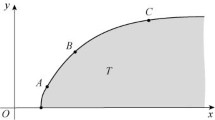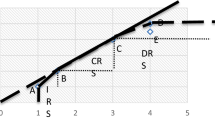Abstract
The concept of Returns to scale is an important topic in data envelopment analysis since it identifies whether the expansion or contraction of the unit under assessment is beneficial. The quantity of the beneficial expansion or contraction is determined by introducing a most productive scale size (MPSS) pattern. This paper aims at introducing a notion of the nearest MPSS pattern which is the closest MPSS pattern among the others. By the aid of this pattern, a unit would be able to reach its optimal size more easily and by small changes in its inputs and outputs. Finding such a pattern is investigated through BCC and multiplicative models.


Similar content being viewed by others
References
Amin, G. R. (2009). Comments on finding the most efficient DMUs in DEA: An improved integrated mode. Computers & Industrial Engineering, 56, 1701–1702.
Banker, R. (1984). Estimating most productive scale size using data envelopment analysis. European Journal of Operational Research, 17, 35–44.
Banker, R. D., Chang, H., & Cooper, W. W. (1996a). Equivalence and implementation of alternative methods for determining returns to scale in data envelopment analysis. European Journal of Operational Research, 89, 473–481.
Banker, R. D., Bardhan, I., & Cooper, W. W. (1996b). A note on returns to scale in DEA. European Journal of Operational Research, 88, 583–585.
Banker, R., Charnes, A., & Cooper, W. (1984). Some models for estimating technical and scale inefficiencies in data envelopment analysis. Management science, 30, 1078–1092.
Banker, R., Cooper, W., Seiford, L., Thrall, R., & Zhu, J. (2004). Returns to scale in different dea models. European Journal of Operational Research, 154, 345–362.
Banker, R., & Maindiratta, A. (1986). Piecewise loglinear estimation of efficient production surfaces. Management Science, 32, 126–135.
Banker, R. D., & Natarajan, R. (2008). Evaluating contextual variables affecting productivity using data envelopment analysis. Operations Research, 56, 45–58.
Banker, R., & Thrall, R. (1992). Estimation of returns to scale using data envelopment analysis. European Journal of Operational Research, 62, 74–84.
Butler, T. W., & Li, L. (2005). The utility of returns to scale in DEA programming: An analysis of Michigan rural hospitals. European Journal of Operational Research, 161, 469–477.
Cao, X., & Yang, F. (2011). Measuring the performance of internet companies using a two-stage data envelopment analysis model. Enterprise Information Systems, 5, 207–217.
Charnes, A., Cooper, W., & Rhodes, E. (1978). Measuring the eciency of decision making units. European journal of operational research, 2, 429–444.
Cook, W. D., & Seiford, L. M. (2009). Equivalence and implementation of alternative methods for determining returns to scale in data envelopment analysis. European Journal of Operational Research, 192, 1–17.
Cooper, W. W., Seiford, L. M., & Tone, K. (2006). Data envelopment analysis: A comprehensive text with models, applications, references and DEA-solver software (2nd ed.). New York: Springer.
Cooper, W. W., Thompson, R. G., & Thrall, R. M. (1996). Extensions and new developments in DEA. The Annals of Operations Research, 66, 3–45.
Ertay, T., Ruan, D., & Tuzkaya, U. R. (2006). Integrating data envelopment analysis and analytic hierarchy for the facility layout design in manufacturing systems. Information Sciences, 176, 237–262.
Eslami, R., & Khoveyni, M. (2013). Right and left returns to scales in data envelopment analysis: Determining type and measuring value. Computers & Industrial Engineering, 65, 500–508.
Hollingsworth, B., Dawson, P. J., & Maniadakis, N. (1999). Efficiency measurement of health care: A review of nonparametric methods and applications. Health Care Management Science, 2, 161–172.
Khodabakhshi, M. (2009). Estimating most productive scale size with stochastic data in data envelopment analysis. Economic Modelling, 26, 968–973.
Mehdiloozad, M., Sahoo, B. K., & Roshdi, I. (2014). Generalized multiplicative directional distance function for efficiency measurement in DEA. European Journal of Operational Research, 3, 679–688.
Ouellette, P., Petit, P., Tessier-Parent, L., & Vigeant, S. (2010). Introducing regulation in the measurement of efficiency, with an application to the Canadian air carriers industry. European Journal of Operational Research, 200, 216–226.
Seiford, L. M., & Zhu, J. (1998). On alternative optimal solutions in the estimation of returns to scale in DEA. European Journal of Operational Research, 108, 149–152.
Seiford, L. M., & Zhu, J. (1999). An investigation of returns to scale in data envelopment analysis. OMEGA, 27, 1–11.
Soleimani-damaneh, M. (2012). On a basic definition of returns to scale. Operations Research Letters, 40, 144–147.
Toloo, M. (2012). On finding the most BCC-efficient DMU: A new integrated MIPDEA model. Applied Mathematical Modelling, 36, 5515–5520.
Toloo, M., & Nalchigar, S. (2009). A new integrated DEA model for finding most BCC-efficient DMU. Applied Mathematical Modelling, 33, 597–604.
Wanke, P. F. (2012). Efficiency of Brazil’s airports: Evidences from bootstrapped DEA and FDH estimates. Journal of Air Transport Management, 23, 47–53.
Wang, Y. M., & Lan, Y. X. (2013). Estimating most productive scale size with double frontiers data envelopment analysis. Economic Modelling, 33, 182–186.
Xing, Y., Li, L., Bi, Z., Wilamowska-Korsak, M., & Zhang, L. (2013). Operations research (OR) in service industries: A comprehensive review. Systems Research and Behavioral Science, 30, 300–353.
Yasar, O. A., Marcos, E. L., Maria, S. C. L., Angela, C. M. D. S., Roberto, F., & Basilio, B. P. (2011). Evaluating the Performance of Brazilian University Hospitals. Annals of Operations Research, 178, 247–261.
Zarepisheh, M., Khorram, E., & Jahanshahloo, G. R. (2009). Returns to scale in multiplicative models in data envelopment analysis. Annals of Operations Research, 173, 195–206.
Zarepisheh, M., Soleimani-damaneh, M., & Pourkarimi, L. (2006). Determination of returns to scale by CCR formulation without chasing down alternative optimal solutions. Applied mathematics letters, 19, 964–967.
Acknowledgments
The authors would like to thank anonymous reviewers for their helpful suggestions during the revision of this paper. This article is based on a research project supported by Islamic Azad University, Neyshabur Branch. Therefore, the authors wish to thank the Islamic Azad University, Neyshabur Branch, for financial support.
Author information
Authors and Affiliations
Corresponding author
Rights and permissions
About this article
Cite this article
Davoodi, A., Zarepisheh, M. & Rezai, H.Z. The nearest MPSS pattern in data envelopment analysis. Ann Oper Res 226, 163–176 (2015). https://doi.org/10.1007/s10479-014-1670-y
Published:
Issue Date:
DOI: https://doi.org/10.1007/s10479-014-1670-y




